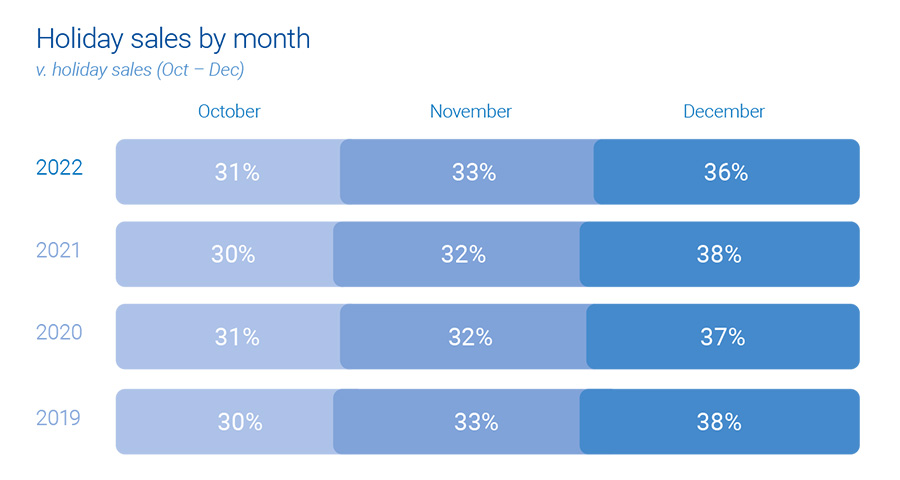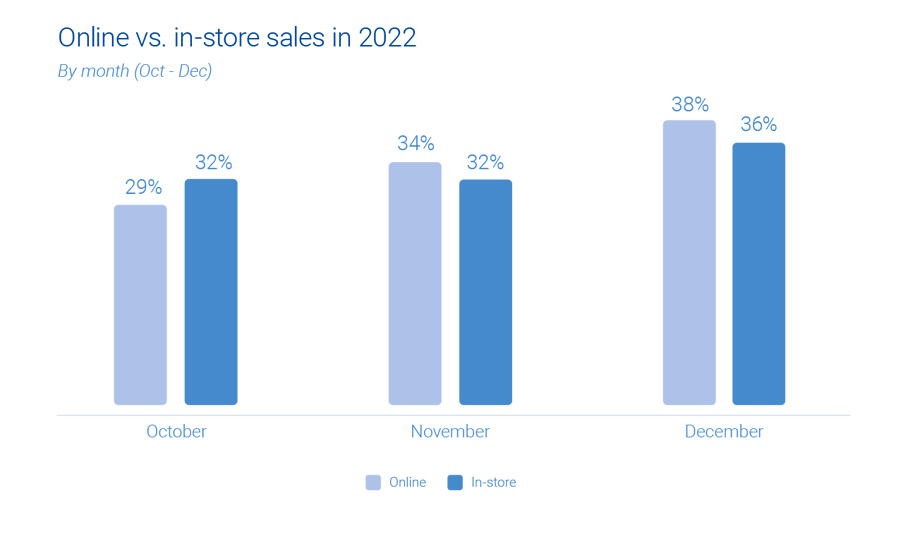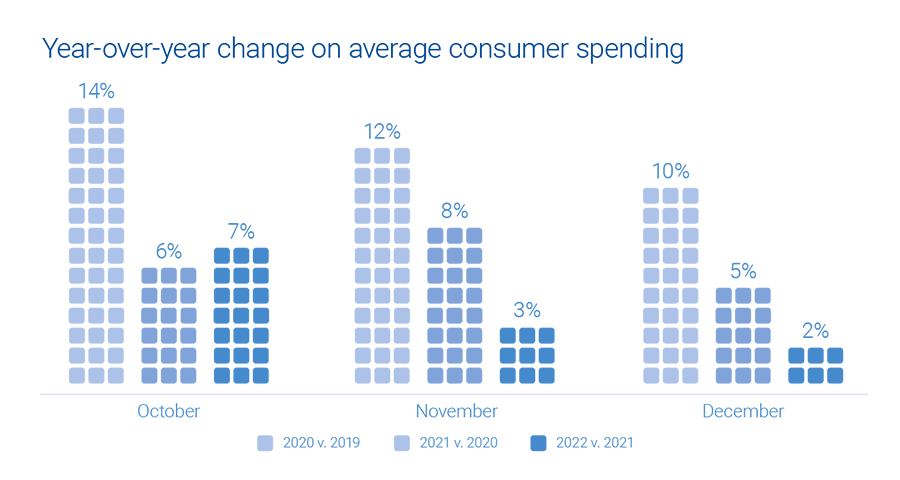
The holiday season is just around the corner, and retailers and marketers are gearing up for the busiest shopping period of the year. It’s crucial to understand how consumer behavior is evolving and what emerging trends to expect. Experian’s 2023 Holiday spending trends and insights report analyzes recent trends, consumer spending habits, and anticipates what’s to come in 2023 to help you deliver a top-notch shopping experience this holiday season.
In this blog post, we’ll cover three key insights from our report.
1. Consumers are shopping earlier
It’s no secret that December has always been the go-to month for consumers when it comes to holiday spending. However, holiday shopping now starts earlier, particularly with online sales.

This can be attributed to a surge in promotions and deals, enticing shoppers to open their wallets ahead of time, giving a significant boost to holiday sales. Notably, Cyber Week sales have proven to be an influential factor, accounting for 8% of total consumer holiday spending.
Experian tip
Reach the right shoppers with your promotions with sell-side targeting. This powerful approach gives you control over where your ads are placed while ensuring maximum visibility through direct connections with publishers. Whether on mobile, web, or CTV, this seamless ad experience will engage your audience effectively.
2. Online sales are on the rise
The popularity of online holiday sales is continuously growing, surpassing in-store shopping. There has been a consistent 1% year-over-year increase in online sales, while in-store sales have seen a 1% decrease.
“It’s easier for consumers to comparison shop for large ticket items online that they might find at a mass retailer or office supply store. Consumers prefer to have larger, bulkier items shipped directly to their home for minimal cost. By shopping online, consumers can save time since they don’t need to wait in checkout lines.”
Anna Liparoto, Sr. Account Executive, Retail & CPG

Although online sales currently make up only one-third of all holiday shopping, there is immense potential for further expansion. Mass retailers and office, electronics, and games industries particularly excel in online holiday sales. While in-store purchases remain the primary choice for holiday shoppers, consumer online and offline activities intersect before the final purchase.
Experian tip
Take advantage of the surge in online shopping by diversifying your marketing channels. An agnostic identity graph can bring together device and media data, capturing valuable user insights. By gaining a holistic view of your target audience, you’ll be able to optimize your ad spend and allocate resources effectively, ultimately boosting your return on investment.
“Omnichannel targeting during the upcoming holiday season will continue to prove to be the best way to reach scale and maximize ROI across all marketing channels.”
Joe LigÉ, Head of Enterprise Demand Partnerships
3. 2023 holiday spending will be on par with 2022
During the holiday season in 2022, consumer spending showed an anticipated increase, although the growth rate was slightly lower compared to previous years. October saw a surge in average consumer spending, indicating a swift response to early discounts and promotions offered by retailers.

As the holiday season progressed, holiday spending gradually slowed down and reached a level similar to that of the previous year. Overall, there was a modest 2% growth. Looking into the future, if economic conditions remain stable in the second half of 2023, we can expect holiday spending to align with the figures from last year.
Experian tip
To truly maximize impact, consider data enrichment. By diving deeper into your target audience’s preferences and behaviors, you can better tailor your strategies and seamlessly integrate the enriched data across various channels. This allows you to unlock the true potential of your ad inventory, creating more meaningful connections with your audience.
Download our 2024 report
Get ready for the holiday shopping season with Experian’s 2024 Holiday spending trends and insights report. Inside you’ll find:
- Analysis of past trends and what they mean for 2024
- Exclusive predictions for the upcoming holiday season
- The top audiences to activate this holiday season
To access to all of our predictions for this year’s holiday shopping season, download our 2024 Holiday spending trends and insights report today.
Latest posts

As marketers, we all want to better leverage data to understand our customer and provide them with the best possible experience. It not only better serves our clients, but is ultimately more profitable for the company. But most of us struggle with large volumes of data, with no idea how to best use it. There are many factors that play into this problem. For most organizations, data is spread out across multiple systems with no consistent data management strategy. That means that as marketers, when we get the data, it comes in a wide variety of forms. The standardization could be different, customers could be missing certain record fields, purchase history could be divided into different accounts…you get the picture. This disparity makes it difficult for us to get any sort of insight from the information. How can we leverage data if it is inaccurate, incomplete and not accessible? Experian Data Quality recently completed a survey of over 250 chief information officers (CIOs) and found that they too are struggling to leverage data. Four out of five see data as a valuable asset that is not being fully utilized within the organization. In speaking with the CIOs, some of the biggest challenges aren’t just about technology, but rather organizational structure and company culture. Sixty-eight percent of CIOs struggle to find stakeholders who take anything other than a siloed view of data management. In addition, 70 percent of respondents say they struggle to implement data-driven decision making because no one seems to own the process. To improve data insight, organizations need to improve the structure around data management. This is where the chief data officer (CDO) comes into play. The chief data officer is a growing c-suite position that is getting more and more popular. Most of the CIOs we spoke with that had a CDO said the role had only been created in the last six months. The reasons companies are looking to put a CDO in place are all related to improving access and insight from data. CDOs are there to: Reduce risk around data-driven projects Curb costs from poor quality data Handle increasing data governance pressures As this role continues to grow, it is going to have a big impact not only on marketing, but also the organization as a whole. With that in mind, join us for a webinar on Tuesday, August 18th at 2 PM EST to talk about the emergence of the chief data officer. We’ll discuss data as an untapped resource, how the role is changing organizations and how to ensure your organization is ready for the shift that this new role brings. Register today!

There is much to be said about the differences between college-age consumers (19- to 21-year-olds) today and their counterparts five years ago. As many marketers recognize, young-adult consumers cannot be targeted based solely on generalizations and assumptions. To accurately and respectfully capitalize on this segment’s buying power, marketers need to understand how their spending patterns have changed in recent years and how to earn a slice of the group’s spend. Accounting for inflation, 19- to 21-year-olds are making more money than young adults did five years ago. Their pay has increased by 20 percent, and, interestingly, their spending has increased by 30 percent. So where are they spending this money? 1. Dressing for success According to Census Area Projected Estimates (CAPE) of expenditure data from Experian Marketing Services, both men and women in this age group are filling their closets with about 35 percent more professional attire — shoes included. This has brought 2015’s average spend up to $22,859 per year per household for college-age women and $11,196 per household for college-age men. This rise in spending on professional wardrobe could be attributed to more professional entry-level job expectations or a possible shift in technical trade positions to business professional positions. CAPE data also reveals a 70 percent increase in memberships to networking and recreational clubs. This increasingly professional outlook among college age consumers requires confidence and the right ensemble to proclaim success. Key takeaway: Position products and services to appeal to this career-minded consumer who is aiming to look the part. 2. “Go with the flow” What kinds of messages resonate with these individuals? According to TrueTouchSM data from Experian, college-age consumers can be best engaged when marketers appeal to them using a “Go with the flow” marketing message. “Go with the flow” has consistently ranked as the top motivating marketing message for college-age individuals in the study. The second and third most resonating marketing messages for this market are “Never show up empty handed” and “Work hard, play hard.” “Go with the flow” means this market has a live-and-let-live outlook on life. Brands who employ a similar outlook, don’t take themselves too seriously and extend no-risk offers may have a better chance to engage this cohort. Key takeaway: If marketers tailor messages around these motivating philosophies, they may have a better chance of earning this market’s business. 3. Offline entertainment For marketers in the retail industry, particularly those with clothing or supplies fit for the outdoors, be aware that this cohort of 19-21 year olds are visiting outdoor apparel and supplies sections more often than they did five years ago. In fact, they are spending 37 percent more on luggage and travel than the same age group 5 years ago. According to the same Experian CAPE study, renting RV’s and increasing spend on camping and winter sports equipment are expenditures getting more attention from college-age consumers this year. Key takeaway: Despite being pegged as a technology-first generation, this cohort also enjoys going “off the grid.” Even if you aren’t selling outdoorsy equipment, be aware that there is more to this age group than smartphones and Netflix. Combine the “go with the flow” attitude with their sense of adventure to better cater your messages to these consumers. A lot has changed in five years. Marketers trying to engage college-age consumers need to understand how spending habits (and motivations) are changing in order to provide the most relevant brand experiences and capture this hard-to-pin-down market. To see how Experian Marketing Services’ rich consumer data can help you profile your best customers, visit our website.

Data may not be the most glamorous aspect of marketing but it is at the heart creating meaningful consumer interactions in today’s data-driven world. In our award-winning, annual Digital Marketer Report we asked senior leaders about their top challenges and priorities. They said things like standing out against competitors, creating relevant interactions and customer acquisition. To my surprise, they didn’t say data. However, all the top challenges and priorities are predicated on having accurate, enriched data that is linked together in a central location for a complete customer view. The sobering fact is that most brands are not there yet. Most are not fully utilizing their data assets and maximizing their marketing intelligence. Take a look at these stats from the Digital Marketer Report to get an idea of where most brands are with data management practices. Overall, 45% of companies collect data via mobile – be it a mobile website, app or both TWEET THIS! 97% of companies suffer from common data errors. 61% of companies named human error as a top reason for data inaccuracies. TWEET THIS! On average globally, companies believe that 23% of their budget is wasted annually due to poor data quality. TWEET THIS! Today, only 35% of companies manage their data centrally through a single director. TWEET THIS! 99% of companies believe achieving a single customer view is important to their business. Only 24% of companies say they have a single customer view today. TWEET THIS! 29% of marketers who enrich their data with third-party data only add one type of data. TWEET THIS! One-quarter of marketers don’t enrich their data with any kind of third-party data. TWEET THIS! It’s important for marketing leaders to understand that they first need to focus on data and creating a customer-centric organization to support good data-management practices. Only then will they be able to reach their goals.